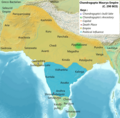Податотека:Chandragupta Maurya Empire c.290 BCE.png

Големина на овој преглед: 612 × 600 пиксели. Други разделности: 245 × 240 пиксели | 490 × 480 пиксели | 784 × 768 пиксели | 1.045 × 1.024 пиксели | 2.099 × 2.057 пиксели.
Изворна податотека (2.099 × 2.057 пиксели, големина: 1,22 МБ, MIME-тип: image/png)
Историја на податотеката
Стиснете на датум/време за да ја видите податотеката како изгледала тогаш.
| Датум/време | Минијатура | Димензии | Корисник | Коментар | |
|---|---|---|---|---|---|
| тековна | 01:21, 19 мај 2024 |  | 2.099 × 2.057 (1,22 МБ) | Levakpitam | minor correction |
| 10:07, 6 декември 2023 |  | 2.099 × 2.057 (1,71 МБ) | Levakpitam | adding Pundra province naming . | |
| 09:08, 6 декември 2023 |  | 2.099 × 2.057 (1,72 МБ) | Levakpitam | minor correction about naming. | |
| 11:51, 4 декември 2023 |  | 2.099 × 2.057 (1,18 МБ) | Levakpitam | adding missing Sudarshana lake . | |
| 10:36, 4 декември 2023 |  | 2.099 × 2.057 (1,17 МБ) | Levakpitam | Uploaded own work with UploadWizard |
Употреба на податотеката
Податотекава се користи во следнава страница:
Глобална употреба на податотеката
Оваа податотека ја користат и следниве викија:
- Употреба на bn.wikipedia.org
- Употреба на el.wikipedia.org
- Употреба на en.wikipedia.org
- Употреба на hi.wikipedia.org
- Употреба на ja.wikipedia.org
- Употреба на ne.wikipedia.org
- Употреба на pa.wikipedia.org
- Употреба на ro.wikipedia.org
- Употреба на ru.wikipedia.org
- Употреба на sa.wikipedia.org
- Употреба на simple.wikipedia.org
- Употреба на si.wikipedia.org
- Употреба на ta.wikipedia.org
- Употреба на uk.wikipedia.org
- Употреба на www.wikidata.org